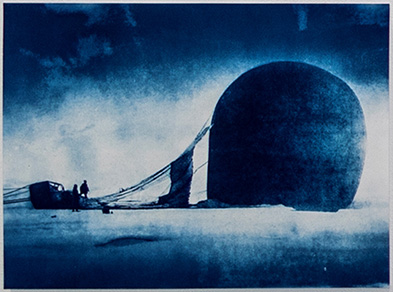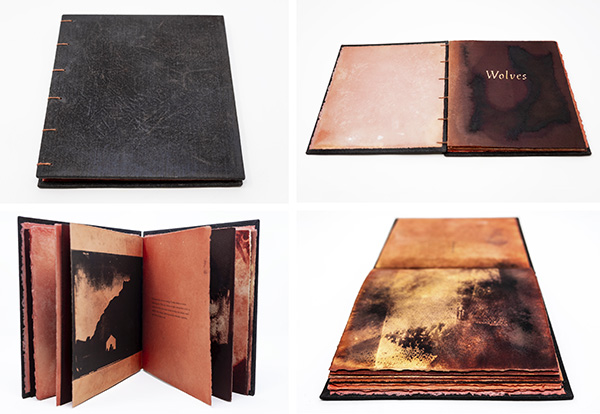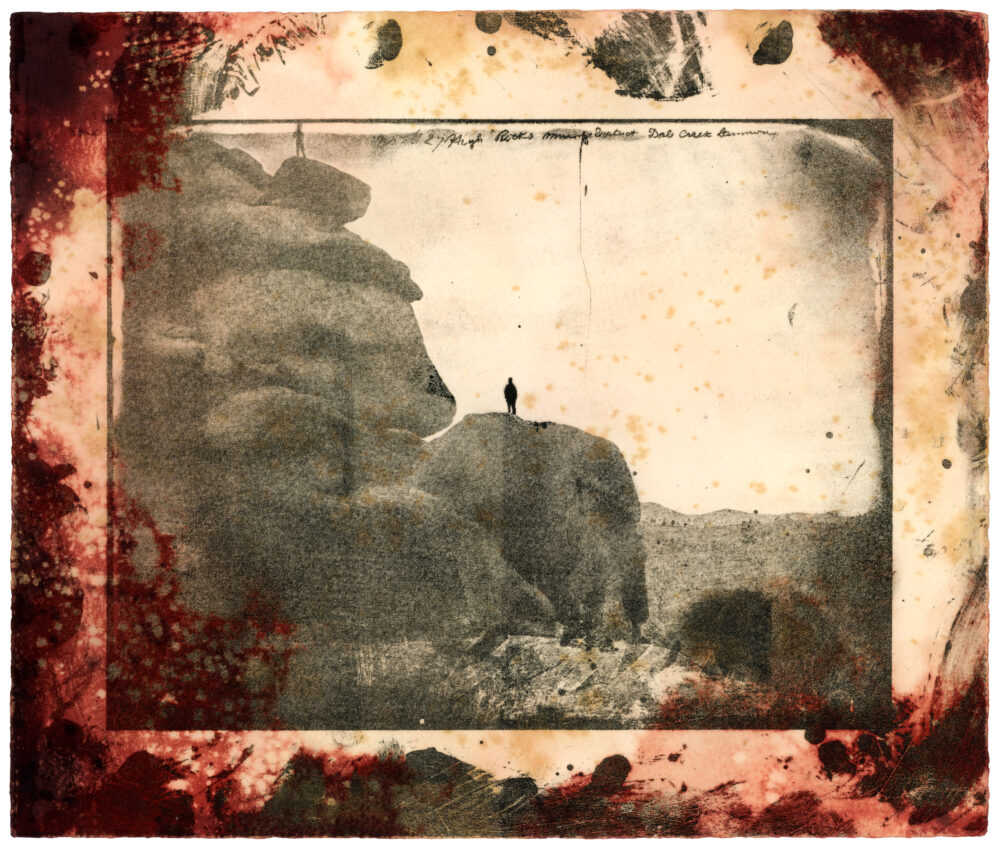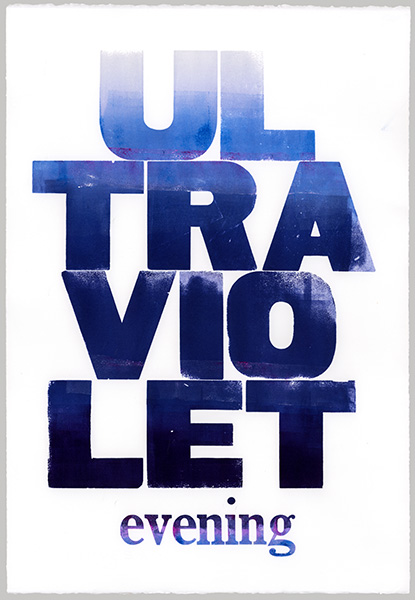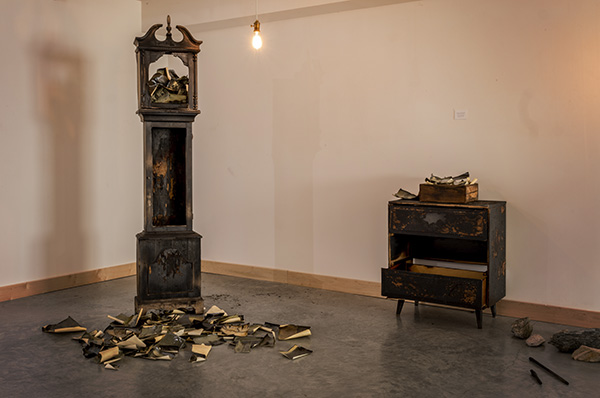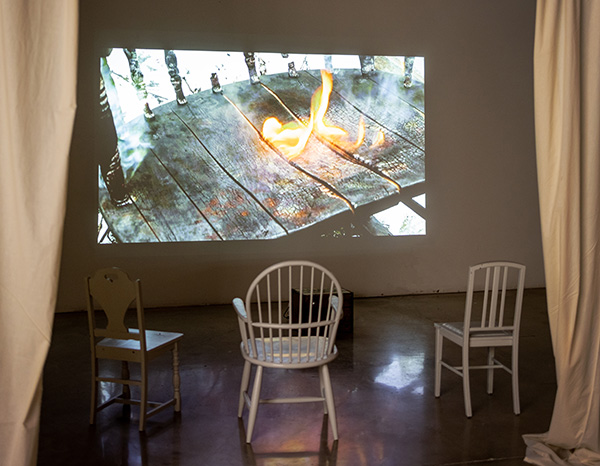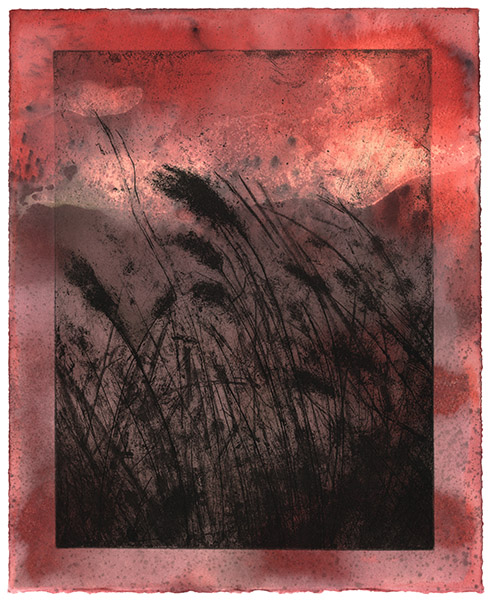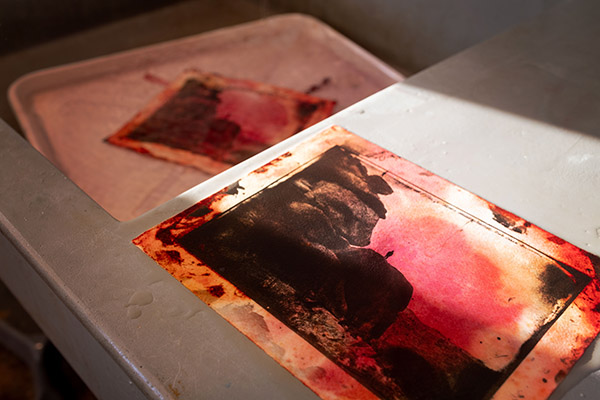A Conversation with printmaker Christopher Hartshorne
During the summer of 2025 I participated in a printmaking residency at In Cahoots Residency in Petaluma, California. In residence were three other printmakers and a poet. We got to know each other a little over the two weeks that we shared space in the studio, on outings, at meals. Christopher Hartshorne and I worked directly across from each other, each at a lovely large etching press. Over two weeks I experienced the gift of observing his process of pulling richly beautiful, futuristic moons–a memorable highlight of my own residency experience.
When we noticed the local blackberries were in and ripe, Chris picked a bunch to bake us a blackberry crumble. It was almost as delicious as Chris’ prints.
This conversation took place towards the end of our residency in the etching studio.
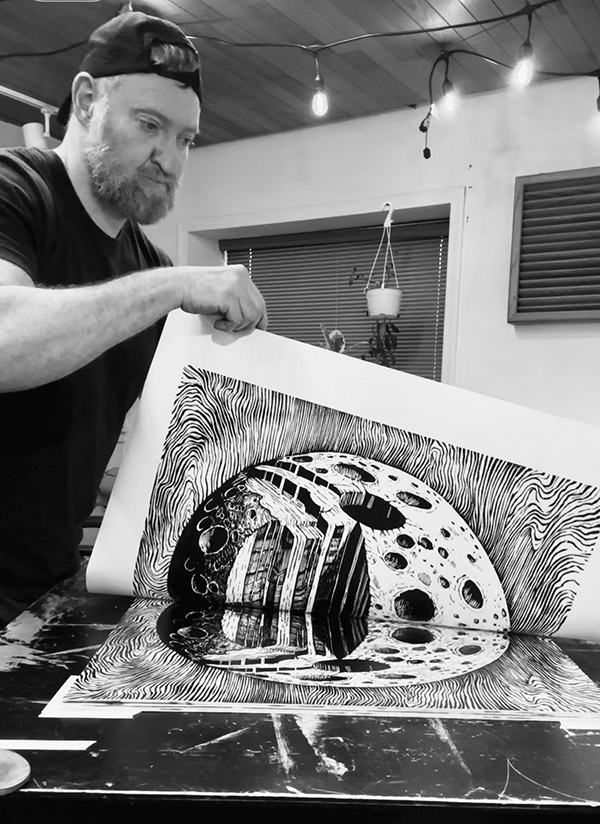
Nanette: How did you come to art?
Chris: I always made art as a kid. I was so shy, I didn’t try other things. Very introverted. It was like an escape, or something that I could do. And I got a lot of positive reinforcement as a kid. I was known as an artist as a kid. So I kind of stuck with it.
Nanette: Like drawing?
Chris: Yes, drawing. I’ve tried to do other things, but I always come back. I’m like, I’m an artist. I’ve got to keep making art.
Nanette: Why printmaking?
Chris: I was painting and I went to school for illustration, never did any printmaking in school, like in college, but when I discovered woodblock printmaking, I liked the process. It was a very definite process. You transfer an image, you carve the image, you print it, you kind of know what it’s going to look like, very graphic. A painting to me was too mysterious. Maybe I didn’t know how to paint. I was a painter, but I didn’t know when a painting was done. There was something really crisp and clear about printmaking and the way I was using it. I latched onto the process immediately. I loved how you could make an expressive, almost random mark on a piece of wood and it looked so defined and intentional when you printed it, because it’s so graphic and bold. That was really cool to me. The marks you can make and how bold they are compared to painting. But now I’m thinking of printmaking differently, actually. A print can be more mysterious, like a painting. So now my views are broadening. That’s how I latched onto printmaking, the process.
Nanette: How long have you been printing then?

Chris: Probably 20 to 25 years. I just started doing it on my own.
Nanette: After school?
Chris: Yes, I was hand pressing, with no community yet. I just started doing it and then kept doing it. I eventually went to grad school for printing, because that’s all I was doing.
Nanette: Many of the artists that I’ve met go in through painting, because painting is seductive and it’s elevated. It used to be, you were a painter or a sculptor. And that’s all there was for fine art. So I think it’s normal to go in through the magic of painting. What grad school did you go to?
Chris: I went to Tyler School of Art.
Nanette: How was your grad school experience?
Chris: It was good. I waited ten years in between BFA and MFA so I was older than everyone. I really wanted to immerse myself in printmaking and school for printmaking, but I actually did not really feel like going back to school. But it was good because they have a program in Rome, through the school, so the whole second year I was in Rome and it was more like a residency, which . . . why am I going to school if I’m just doing an artist residence? But it was really amazing. I would never have gone out of the country back then if it wasn’t for the program. It was my first time out and it was pretty cool. I had a small cohort of five other grad students from Tyler and a bunch of undergrads that were from a lot of different schools, just getting some international school experience. It was good.
I was scared to leave the country. I don’t know. I’m a homebody, but it was really, really amazing for me to leave, and see more than just the art experience.Just to see how other people live, non Americans, [laughs] was very good for me to see as an artist and a human, or an American, I guess, so that was pretty cool.
Nanette: You were in your 30s then?
Chris: I was 30 something.
Nanette: I went to grad school late too. And it was weird to be one of the oldest people. I think I went when I was 38. And they were all so young.

Chris: I feel like I fit in. It was just that I kind of was over school, even though I wanted to go back, if that makes sense. I think if I could have found or put myself into a printmaking community, that would’ve also done the trick, but I needed school to help me with that, too.
Nanette: I think that’s why people go.
You’re originally from?
Chris: I’m from New Jersey. East Coast.
Nanette: Urban?
Chris: No, it’s actually pretty rural. I grew up in a house that used to be a farm. It’s known as the Garden State, which people who think that New Jersey is just like the waste of New York, are like, the Garden State? That doesn’t sound right, but there are rural areas. I was equidistant from Philadelphia and New York so could go on a trip to either pretty quickly.
Nanette: Did you do that as a young person?
Chris: I did. My parents would take me and there were school trips, and then we would go as teenagers. Now that I live on the West Coast, I’m like, oh my God, that was so close. I could have gone every weekend to New York. Because now Seattle is my New York, Seattle and Vancouver, but they’re so far away. I’m in between them. I miss New York, even though I never lived there. What would have happened if I moved there?
Nanette: What is your work about, historically, when you first started feeling maybe professional or serious? What was your content?
Chris: It was woodcut, woodblock print. They were large scale banners when I first started showing. Very abstract, and I would say. . . That’s a great question. What are they about? Because I feel like I have a lot of answers to that and one of them is, I don’t know. But I think I really wanted to overwhelm the viewer. So there’s lots of swirling energy. I was thinking about how does that connect to nature? Very organic forms. Thinking about microscopic and macroscopic. I made these huge banners with very large shapes, but if you went in really close, there was really tiny marks. So it was playing with scale, big and small in the same piece.
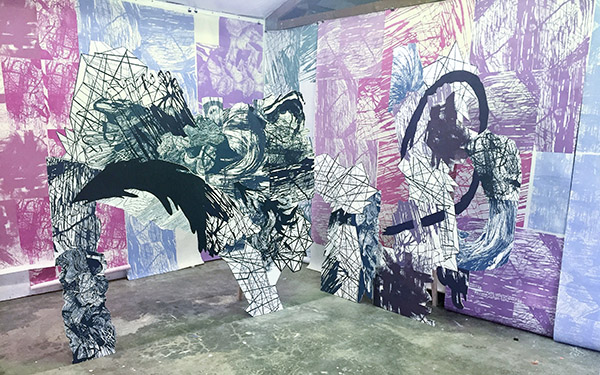
I’m drawn to installation. I’m not really satisfied with things I make unless it becomes something bigger. This is kind of a boring answer, but it’s also just about composition. I get a lot of satisfaction composing an image with shapes or stenciling off things and connecting, making things grow. I should show you my non-moon work.
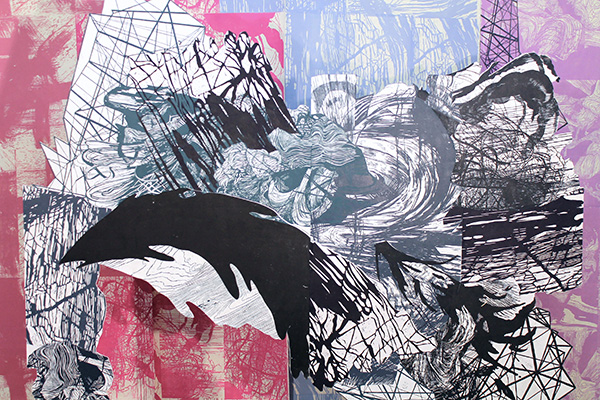
Nanette: I saw on your website a lot of color. Really intense, vibrant, big shapes.
Chris: A lot of times I make stuff and I think about what it means to me after, because I do a lot of playing or experimenting, and then I start thinking about it more and more as it develops, my abstract stuff anyway.
I think with the color work you saw, I was thinking about maps as I was making it. I didn’t set out to make a map, but I used a system of creating triangular backgrounds in one body of work. Triangles point in directions. They look like they’re symbols or yield signs, so it started feeling like a really bizarre, maybe undecipherable map. Like another language. Even the colors would mean something. It’s cool to have that grow on a wall because someone literally has to travel through the piece. So it becomes a map to them, too, even if they don’t know it.
Nanette: Maps are interesting. I’ve always liked looking at maps, and now with our phones, when we travel, a lot of times I take screenshots of the map. I like to zoom in and out and see where things are.
Chris: I do, too.
Nanette: The narrative of the maps, did you keep that inside internally? Or did you write about that or talk about that at the time?
Chris: I shared it minimally for show statements and artist’s statements. It took so long to create that I started putting elements in consciously thinking about maps while I was making it. It wasn’t just after. I remember putting stripes in that looked like diamond yield signs. You know when you see a road turning, there’s this weird curve. I put some of those in there. I was even thinking of street art or textures.
Nanette: They were directional or alluding to direction?
Chris: Yes.
Nanette: Did you like that? You made a funny face so I’m wondering, did you like those works?
Chris: Oh, yeah. I don’t know why I made a funny face.
Nanette: Maybe it’s all this language running around us.
Chris: Yeah.
Nanette: Right now you’re working on these moons. And they’re kind of maps too, in a different sort of way.
Chris: They could be maps or related to maps. I mean, they’re places. Right? A moon or a planet. I see them as metaphors. If one of them has a chunk taken out of it, that has some type of meaning as opposed to one that’s plummeting through space.
Nanette: Do you know what that meaning is?
Chris: Not exactly. [laughs]
Nanette: What brought you to start making the moon work?
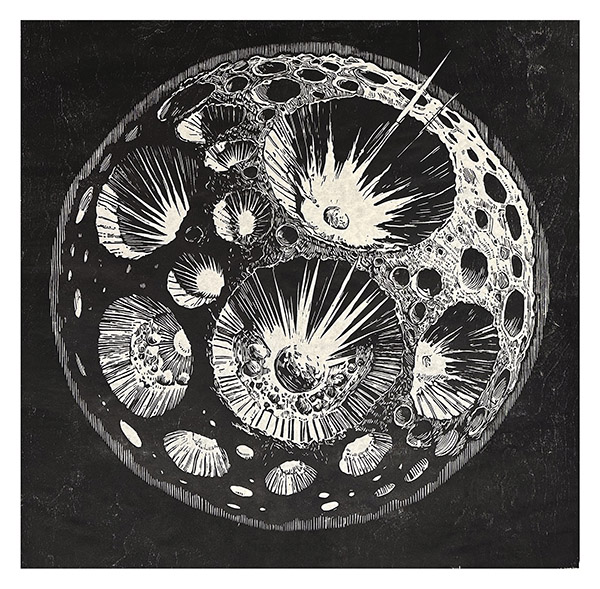
Chris: I’m not sure. Well, there is the image itself. I’m interested in sci-fi. I was reading some. I’m watching a lot of movies that have sci-fi as almost like a background. It’s a kind of a horrible movie to watch, but Melancholia, where a planet’s going to crash and nobody can do anything. But it’s really about this relationship between these two sisters, and that’s just kind of like a subplot almost. I kind of like having that kind of theme. It could have been a disaster movie where they showed the city burning, but it was not about that. It was about relationships. So I think about that a lot.
What does this mean or what kind of metaphor could this be for someone’s life. A lot of the moons have pieces missing or are incomplete or have some drama going on, like lava. But I feel like they’re well carved and look detailed, so they’re both dramatic and maybe unstable, but also there is something stable about them because they’re nice and drawn well. You know what I mean? I’m just thinking about this right now actually. I’m like, oh, that’s interesting. Those are two different forces or ideas.
Nanette: And they are smaller than your previous work.
Chris: In my mind, I was making this big. Wouldn’t it be cool to make it for a specific space and just cover the whole wall with moons. It’s almost like a graphic novel, which I’ve also been looking at a lot. . . the narratives in graphic novels.
What would happen if you saw the same circle in different ways? Could I elicit a story out of that? I don’t know. Maybe just not a very specific story, but just a journey.
Nanette: So big moons, a big moon installation. Would those be prints? Would those be woodcuts?
Chris: Yes.
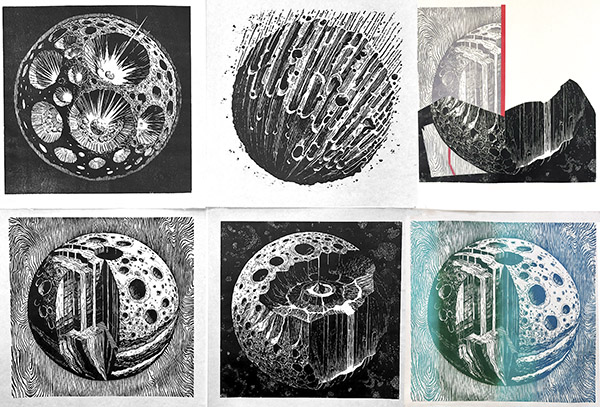
Nanette: Are you married to woodcut?
Chris: I think I am, and sometimes I ask myself, Why? Because, as I work on these, I’m like, you know what, should this be an etching? I’m trying to get the most detail I can out of a piece of plywood and I could get a lot more detail out of an etching. So that’s been on my mind. Or even wood engraving. To get that detail, I have to work this big, but I could go smaller in a wood engraving. I don’t know. So I feel like I’m married to it and I’m thinking about cheating. Not cheating, because. . . I don’t know.
Nanette: Having an affair?
Chris: Yes. It’s different.
I have done some paintings. Especially when I was thinking more about color, I’m like, I’ll just do a painting. I wanted to put all these colors into a piece so I did a lot of gouache paintings.
Nanette: What’s the scale on those?
Chris: I think the biggest ones are 32 x 40, a big piece of watercolor paper. I’m painting like a printmaker or they look like prints because they’re very graphic, not a lot of blending of the colors. It’s very graphic which is very satisfying. I guess I’m into graphic color and shape. I think I need to think about that more because I do feel like the medium can change based on the idea or what’s best for the idea, you know what I mean, or the outcome.
There’s something about woodcut, I guess. You know, one thing about it is that I don’t need anything, really. I can do it anywhere I want. That has been a big deal. I started doing it with no studio, in my bedroom. So I think I’m still holding on to that.
Nanette: Do you use regular plywood or is it birch plywood?
Chris: It’s birch plywood. I like birch.
Nanette: Does birch have knots?
Chris: Yes, I either incorporate them or try to ignore them, which is hard, because they’re very tough. Birch is hard enough to get detail, but not as hard as some wood. So it’s kind of in between, not as soft as pine, which would just flake away or be too soft.
Nanette: I tried to laser etch some plywood. It was really hard to get an even burn. I don’t know, it was like Home Depot plywood, but if there was a knot, it was just kind of disastrous.
Chris: I did it with plywood. I was at Oregon College of Art at a residency in 2018. I didn’t really make anything. I just went there every day and used their laser cutter. I made 20 wood boxes. It seemed to be fine. I just had to change the setting so it would go deeper. It took two hours for this size. [indicates with hands] I think they were getting annoyed that I was using it so much.
Nanette: You were bogarting that.
Chris: And really putting it to work.
But that’s another thing. Since I’m talking about it. Putting a digital technology with old school printmaking is kind of interesting. I never really explored that, but some of the images actually were created from patterns from white noise screens. So it was kind of like thinking about digital stuff, but making it into a woodcut which I thought was interesting. Taking digital imagery and using digital technology, then printing it old school like.
Nanette: Translating.
Chris: That’s a good word.
Nanette: So you’re not a purist then?
Chris: I don’t think so. I’m still learning about printmaking, actually. I never did any printmaking in undergrad. And even in grad school, you were kind of on your own, like, “Make a big project.” So I didn’t learn everything that I could have about printmaking. I’m still actually learning more things, little things. . . oh, you can do that? So I don’t feel like a purist because I’m just using the knowledge I have and I don’t even think I have all the knowledge to be a purist. I’m not a hardcore printmaker. I’m hardcore woodcut person.
Nanette: It’s interesting because there are these different schools. There are printmakers who embrace all the new technology. Riso is being accepted in the fine art print community. And then there’s some people who are like, oh, my God, you used a laser for that? They don’t accept any technology, or I should say any digital technology. So it’s interesting that there’s that mix.
Chris: I don’t have a problem with that. I guess if it takes away from your brain doing some work, if it’s doing too much work, maybe I don’t know depends on what it is.
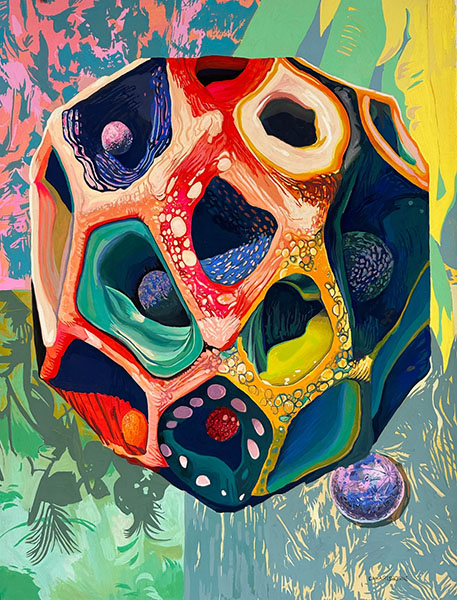
Nanette: You teach as well?
Chris: I teach mostly, drawing and foundations courses, like 2D design, and then about one or two times a year I teach a printmaking or a relief class. It’s fun. Printmaking is harder than just teaching drawing, because there’s all the processes and cleaning is crazy. They really need to clean better. But it keeps me on my toes. It’s keeps me thinking about what I’m making too. They influence me and even the things that I’m showing them, like other artists. It’s also affecting me, my work, so that’s a perk. And I like the kids, too. It’s not all about me.
Nanette: Are they mostly young?
Chris: Yes. They are new art majors, freshmen or sophomores probably.
Nanette: Are you thinking of the next project or the next residency?
Chris: I’m thinking about these moons and how I can make them bigger. So that’s on my mind.
Nanette: Do you do residencies regularly?
Chris: Every couple years. This is the second year in a row at In Cahoots. I did a couple at universities, which was cool because I had more time to take off. It was like six to eight weeks and I really could develop something, not even knowing exactly what it would be, but I knew it was going to be good because that’s a lot of time. I came up with these big installations through residencies. So I guess I would love to do one of those again for a long term project if I could find the time or the right part of the year. It’s interesting how life can get in the way of art.
Nanette: That’s kind of the point. And then all that things that get in the way influence the art and change it.
Is there anything else we should know about you?
Chris: How many hours you got? No. I can’t think of anything. I’m trying to think of a funny anecdote.
Nanette: You’re a cook.
Chris: Well, you’ve seen me make a crumble, but I don’t really cook that much. Only because my partner does. And he’s so good. It’s like, I feel spoiled. But I can cook if I have to.
Christopher Hartshorne received his BFA in Illustration from The Columbus College of Art and Design and his MFA in printmaking from Tyler School of Art in Philadelphia. His woodcuts have been exhibited at The Philadelphia Museum of Art, The William Penn Foundation, The Woodmere Art Museum, The Art Institute of Philadelphia, The Delaware Art Museum, The Romanian Academy in Rome, and The Fleisher Art Memorial Wind Challenge series. He has been a fellow at the Center For Emerging Visual Artists and also with The New Courtland Artist Program. Christopher has taught at the Rhode Island School of Design, Tyler School of Art, and has taught in many public school connected art programs throughout Philadelphia, including The Mural Arts Program, The Arthur Ross Gallery at the University of Pennsylvania, The Print Center and The Philadelphia Museum of Art. He has completed artist residencies at The Oregon College of Art & Craft (2018); The Sylvia J. Smith Artist in Residence at Dickinson College (2019); and at InCahoots (2024, 2025). Christopher currently lives in Bellingham, Washington and teaches at Western Washington University.
christopherhartshorne.com
In Cahoots Residency
This interview was conducted in August 2025 at In Cahoots Residency by Nanette Wylde.



